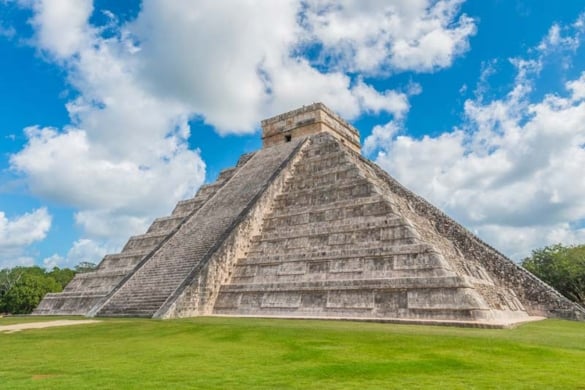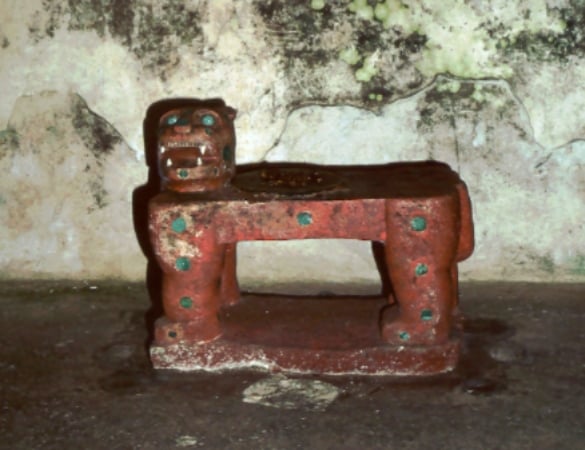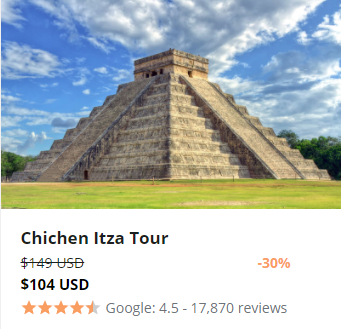Explore Many of the Iconic Ancient Ruins of Chichen Itza

The ancient city of Chichen Itza was built upon broken terrain by the Mayans between 750 and 900 AD. The ground was artificially levelled in order to build structures that can still be seen today. Archeologists have identified distinct architectural groups among the densely clustered architecture of the site. These groups were once separated from each other by a series of low walls. These groups include the Great North Platform, the Osario Group, and the Central Group.
The Great North Platform encompasses many of the iconic ancient ruins of Chichen Itza including:
- Temple of Kukulcán (El Castillo)
- Great Ball Court
- Temple of Warriors
- Sacred Cenote
- Temple of the Bearded Man
- Temples of the Jaguar
- Group of a Thousand Columns
- Temple of Carved Columns
- Temple of Small Tables
- Thompson’s Temple/ Palace of Ahau Balam Kauil
- El Mercado
1. Templo de Los Jaguares/Temples of the Jaguars
The Temples of the Jaguars are attached to the east wall of the ballcourt complex. They were built in a combination of Mayan and Toltec styles.
The Upper Temple of the Jaguar has two stone columns carved with feathered serpent, and a large mural inside depicting a battle scene.
The Lower Temple of the Jaguar has a jaguar throne and the walls inside the temple and the outer columns are covered with bas-relief carvings.
2. Great Ball Court (Gran Juego de Pelota)
The Great Ball Court is located about 150 meters North-West of El Castillo. It is an impressive example of a Mesoamerican ball court. The court was used for major formal ball games, often held as part of ritual events.
The Mesoamerican Ballgame was a sport played by the pre-Columbian people of Mesoamerica. The sport used a solid rubber ball that could weigh as much as 4 kg (9 lbs.), however the ball varied in size according to the version played. The goal was to put the ball through the ring on the wall. The ball was struck with the players’ hips, heads, elbows and/or legs. Archeological evidence suggests some versions of the game were also played using wooden sticks, racquets, bats and/or hand stones. The exact rules of the game are unknown.
There are 7 courts for playing the Mesoamerican Ballgame at Chichen Itza, but the Great Ball Court is by far the most impressive and is the largest in the area measuring 168 by 70 meters. The base of the interior walls include sculpted panels of ball players, including one where a player is decapitated. Parallel platforms 8 meters (26 ft) high surround the main playing area and hold the goal ring that is carved with intertwined feathered serpents.

3. Tzompantli or Platform of the Skulls (Platforma de los Craneos)
This type of palisade was used by the Mayans to publicly display human skulls, typically of sacrificial victims or captives of war. The skulls were impaled vertically on this platform that is adjacent to the Great Ball Court.
Human sacrifice on a large scale was introduced to the Maya by the Toltecs from the appearances of the tzompantli by the Chichen Itza ball courts.
Six ball court reliefs at Chichen Itza depict the decapitation of a ballplayer; it seems that the losers would be beheaded and would have their skulls placed on the tzompantli.

4. Platform of Venus (Plataforma de Venus)
This platform is north of El Castillo and was dedicated to the planet Venus. Inside the platform is a large collection of large cones carved out of stone. Archeologists are unsure of their purpose.
5. The Sacred Cenote (Cenote Sagrado)
While not on the Great North Platform, the Sacred Cenote north of El Castillo was a place of pilgrimage for ancient Maya people. Cenotes are natural sinkholes filled with water that are common in the Yucatan Peninsula (a limestone plane). Swimming is not permitted in the Sacred Cenote.
Historians believe the Sacred Cenote was used to conduct sacrifices during times of drought. Chichen Itza was thought to be originally constructed for proximity to the sacred site. Archeologists have recovered thousands of objects from the bottom of the cenote including human skeletons, pottery, carved jade, flint, gold, obsidian, shell, rubber, cloth and wood.
6. The Temple of the Small Tables (Templo de las Mesas Pequeñas)
The Temple of Small Tables is the northernmost of a series of buildings to the east of El Castillo. It is an unrestored structure. It is named for the series of altars at the top of the structure that are supported by small carved figures of men with upraised arms, called "atlantes."
7. The Temple of the Warriors (Templo de Los Guerreros)
The Temple of Warriors is a large stepped pyramid surrounded by rows of carved columns that depict warriors. When the city was inhabited, the columns would have supported an extensive roof system.

This Temple of Warriors at Chichen Itza is analogous to Temple B at the Toltec capital of Tula (1,487 km from Chichén Itzá) and indicates some form of cultural contact between the two regions. The Temple of Warriors at Chichen Itza, however, was constructed on a larger scale. A Chac Mool sits at the top of the pyramid.
This temple encases The Temple of the Chac Mool. The Carnegie Institution of Washington restored this building during their archeological expeditions from 1925 to 1928. Earl H. Morris published his work in two volumes entitled Temple of the Warriors.
The Temple of Warriors deteriorated rapidly after archaeologists exposed the ruins to the elements. Watercolors were made of murals in the Temple of the Warriors that depicted battle scenes. Some depict tantalizing images that lend themselves to speculation regarding possible contact between the Maya and Viking sailors.
8. El Castillo - The Pyramid of Kukulcán
El Castillo is the most famous landmark of Chichen Itza. The pyramid is a temple dedicated to Kukulcán, a Mayan feathered serpent deity. The Pyramid of Kukulcán was nicknamed "El Castillo” or “The Castle" by the Spaniards who briefly conquered the city in 1532.
The pyramid is 30 meters (98 ft) high, with the sides of the pyramid rising 55.3 meters (181 ft) at a 53° angle. Each face of the pyramid has stairways that reach a 6 meter (20 ft) temple at the summit.

Around the equinoxes, light passing the northwest corner of the pyramid casts a series of triangular shadows that appear to depict a serpent wriggling down a staircase. The Pyramid of Kukulcán is an example of the Mesoamerican practice of superimposing larger structures over older ones.
In the 1930’s the temple was excavated, and they discovered another temple below the current one. The temple contained a throne in the shape of a jaguar and a Chac Mool statue.

9. Group of a Thousand Columns (Grupo de las mil columnas)
Along the south wall of the Temple of Warriors are a series of what are today exposed columns. The columns form three distinct sections:
- The northeast group which formed a small temple decorated with carvings of people or gods, serpents and animals. This group also contains an engineering marvel; a channel that funneled water 40 meters away from the complex.
- The west group that extended the lines of the front of the Temple of Warriors
- The north group that contains columns with carvings in bas-relief, primarily of soldiers.
Temple of the Carved Columns
A small temple that contains an altar with a Chac Mool. The numerous columns have rich bas-relief carvings that depict 40 individuals.
Thompson's Temple (Palace of Ahau Balam Kauil)
Thompson’s Temple is a small two-level ruin with friezes depicting Jaguars and glyphs Kahuil (a Mayan god).
10. The Market (El Mercado)
A square shelf of stone that surrounds a large gallery and patio. Early archaeologists believed this area was used as a marketplace. Modern archeologists suggest the structure was used for ceremonial purposes. A structure at the southern end of the Temple of Warriors.
On your next visit to the Mayan Riviera, explore Chichen Itza in person with a breathtaking tour with Cancun Adventures.



